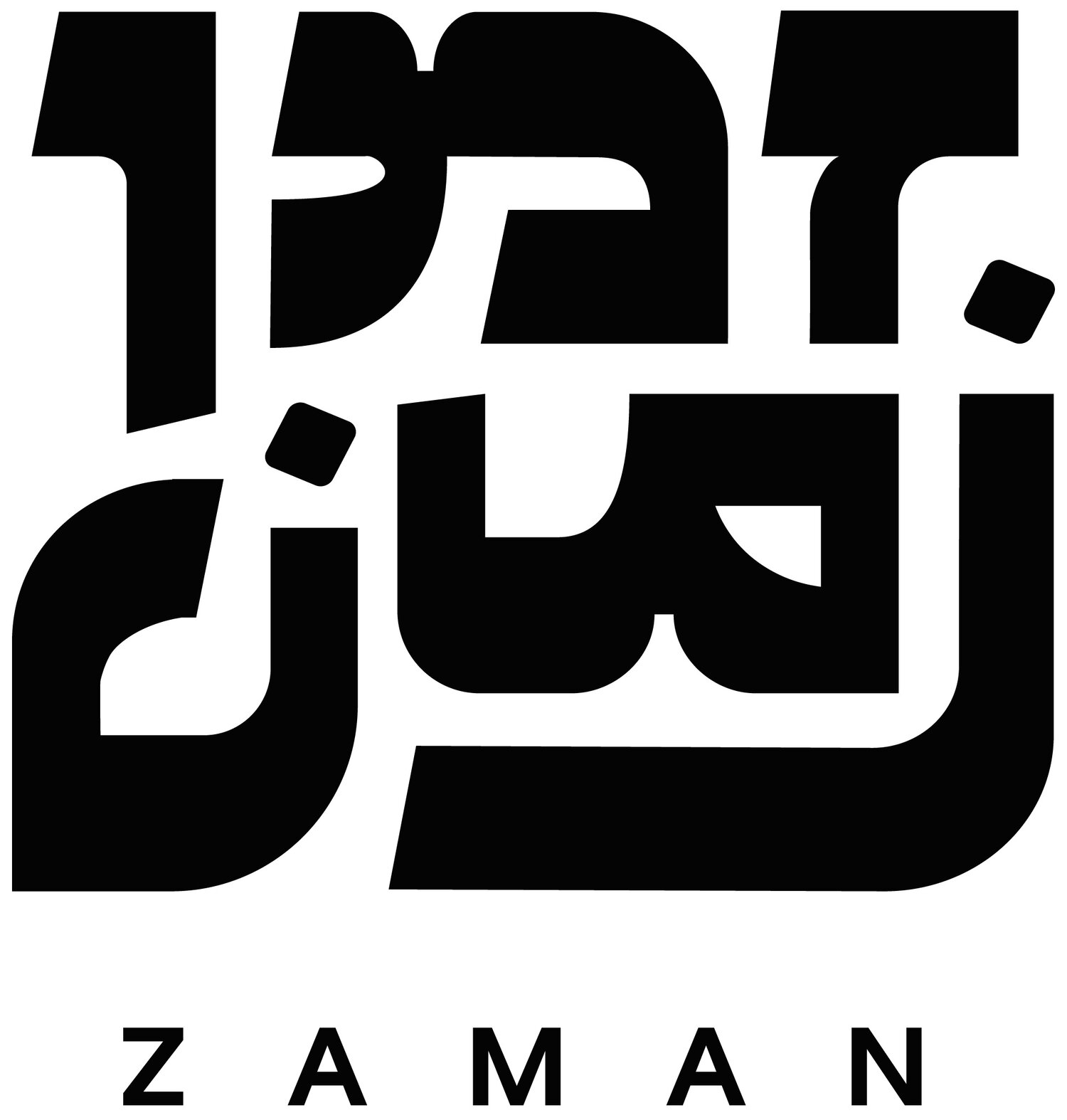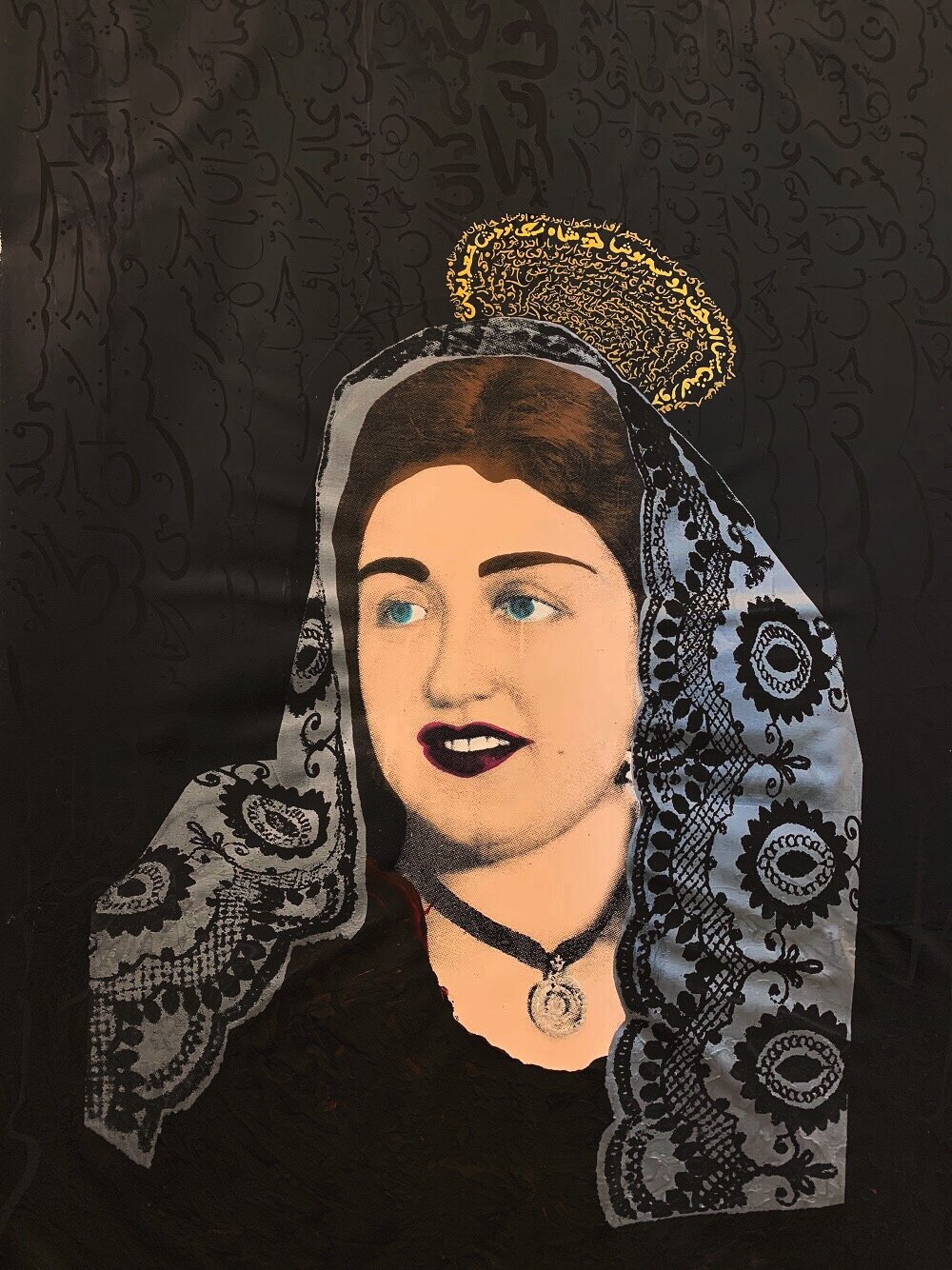Mahin (Diptych)
Words by Sophie LevyBetween January and February 2019, Evan Mateen made two screenprints derived from a portrait of his great-grandmother taken in 1937. The diptych, comprised of two prints on 44″ x 70″ unstretched canvas, marks a more ambitious turn in Mateen’s body of work with screenprinting. He continues his conceptual trend of paying homage to family members by giving new life to old photographs, immortalizing their images in modern formats with synthetic materials that produce high levels of contrast.
However, this diptych arguably transcends the role of the family portrait as it comments on the place of Iranian Jewish women in a broader national culture largely built on Islamic history, lore, and spirituality. The prints’ pop-art flair also serves to ironically question flattening, simplistic understandings of Jewish acculturation into Muslim Iran. Rather than accepting the inherent complexity and nuance of Persian Jewish sociocultural history, it can be easy to view the existence of Jewish life in Iran as “incompatible” with its backdrop of national history dominated by Shi’a Muslim influence.
Mateen simultaneously provokes such criticisms of simplistic perceptions of Iranian Jewish life and acknowledges the ways in which it actually did intertwine beautifully with facets of Muslim Persian culture, such as Sufi mysticism. Mateen was initially introduced to the history of interactions between Jewish and Sufi mystics while studying the Rambam and the concept of “Jewish Sufism” that arose in religious philosophies hailing from the twelfth century.
For instance, the canvas on the right includes a lengthy excerpt of the classical epic poem Vis and Ramin, subtly visible in the background and continuing to wrap around the figure’s head like a halo. Mateen’s inclusion of this intricate love poem serves as a medium to ponder the complex relationship his Jewish family holds with the influence of Muslim Persian culture (as previously discussed) while also paying a sweet tribute to his great-grandmother Mahin, a beloved, “larger than life” matriarch on his mother’s side of the family.
Scroll down to view the diptych and to read an English translation¹ of the aforementioned excerpt from Vis and Ramin.
چو قامت بر کشید آن سرو آزاد
که بودش تن ز سیم و دل ز پولاد
خرد در روی او خیره بماندی
ندانستی که آن بت را چه خواندی
گهی گفتی که این باغ بهارست
که در وی لالهای آبدارست
بنفشه زلف و نرگس چشمکانست
چو نسرین عارض لاله رخانست
گهی گفتی که این باغ خزانست
که در وی میوهای مهرگانست
سیه زلفینش انگور ببارست
زنخ سیب و دو پستانش دونارست
گهی گفتی که این گنج شهانست
که در وی آرزوهای جهانست
رخش دیبا و اندامش حریرست
دو زلفش غالیه، گیسو عبیر است
تنش سیمست و لب یاقوت نابست
همان دندان او درّ خوشابست
گهی گفتی که این باغ بهشتست
که یزدانش ز نور خود سرشتست
تنش آبست و شیر و می رخانش
همیدون انگبینست آن لبانش
روا بود ار خرد زو خیره گشتی
کجا چشم فلک زو تیره گشتی
دو رخسارش بهار دلبری بود
دو دیدارش هلاک صابری بود
بچهر آفتاب نیکوان بود
بغمزه اوستاد جادوان بود
چو شاه روم بود آن ری نیکوش
دو زلفش پیش او چون دو سیه پوش
چو شاه زنگ بودش جعد پیچان
دو رخ پیشش چو دو شمع فروزان
چو ابر تیره زلف تابدارش
بار اندر چو زهره گوشوارش
ده انگشتش چو ده ماسورهء عاج
بسر بر هر یکی را فندقی تاج
نشانده عقد او را درّ بر زر
بسان آب بفسرده بر آذر
چو ماه نَو بر او گسترده پروین
چو طوق افگنده اندر سرو سیمین
جمال حور بودش، طبع جادو سرینِ
گور بودش، چشم آهو
لب و زلفینش را دو گونه باران
شکر بار این بدی و مشکبار آن
تو گفتی فتنه را کردند صورت
بدان تا دل کنند از خلق غارت
وُ یا چرخ فلک هر زیب کش بود
بر آن بالا و آن رخسار بنمود
She grew into a silver cypress tree,
Her heart was steely, and her spirit free,
And Wisdom gazing on her lovely face
Was baffled to describe her radiant grace.
It said, “She is a garden burgeoning
With all the freshness of the early spring,
Her eyes are two narcissi, and her hair
The purple violets darkly nestled there,
Her face is formed from tulips and wild roses.”
But then it said, “It’s autumn that composes
Her loveliness, not spring, and she is made
Of fruits that ripen in autumnal shade:
Her hair is clustered grapes, her breasts now show
The shape of pomegranates as they grow,
Her chin is like an apple, sweet and round.”
And then it said, “In this sweet girl is found
The riches all the world desires, and she
Is like a wealthy royal treasury:
Her skin is silk, her face is rich brocade,
Her hair the essence from which scents are made,
Her body’s made of silver, and beneath
Her ruby lips peep priceless pearls, her teeth.”
And then it said, “But God has formed her of
His own refulgence, and celestial love,
And in her body all components meet
That make the walks of paradise so sweet,
The water and the milk, her cheek’s red wine,
The honey of her lips, are all divine.”
It’s no surprise if Wisdom missed the mark,
Since heaven’s eye, in seeing her, grew dark.
Her cheeks would steal spring’s heart, when Patience spied
Her lovely eyes it sighed for them and died;
Her face was like the sun, in coquetry
She was the mistress of all sorcery.
Like some pale Western king, her face was white;
Her braids were guards, dressed blackly as the night,
And, like a royal African’s, her hair
Glowed from her cheeks’ bright torches, burning there.
Her curls were like a black cloud, and amid
Its darkness Venus, her bright earrings, hid.
Her fingers were ten reeds of ivory,
Their nails were filberts fitted cunningly,
Her necklace was like ice that coalesced
Upon the conflagration of her breast,
As though the splendid Pleiades were strewn
Across the shining surface of the moon,
As though a glittering torque should somehow be
Fitted around a silver cypress tree.
She was a houri in loveliness,
In inward strength she was a sorceress,
Her eyes were doe’s eyes, and you’d say that her
Plump rump belonged upon an onager.
Her lips rained sugar down, and everywhere
She walked musk wafted from her perfumed hair;
And you would say that subtle mischief made
Her face to plunder hearts as its cruel trade,
Or that this lovely creature had been given,
All of the beauty that was owned by heaven.
¹ Gurgānī Fakhr al-Dīn, and Dick Davis. Vis and Ramin. Penguin, 2009.




